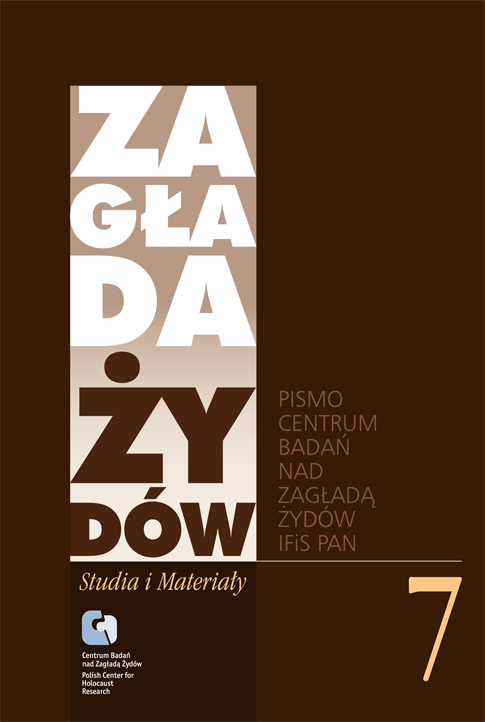60 Years of Coping with the Lack of Identity
Zagłada Żydów. Studia i Materiały, No. 7 (2011), Pages: 318-339
Submission Date: 2020-12-13Publication Date: 2011-12-10
 https://doi.org/10.32927/zzsim.789
https://doi.org/10.32927/zzsim.789
Abstract
The article deals with the phenomenon of “children without identity,” i.e. children rescued from the Holocaust born in Poland during 1936–1945 who lost both their parents. They can be divided into two groups: the saved ones who lost their identity during the war or right afterwards (of whose past we know nothing; sometimes the only piece of information is the name given to them by the Poles during the war) and the saved ones whose identity was lost during the process of emigration (children who remembered their names and could talk about their parents and their past at the end of the war, but who forgot everything later on). The author discusses the condition of the archive materials about “children without identity” and about their lot: about the ways of adaptation in Israel and Poland, traumas, reasons for not speaking about their identity loss and the search for their past.
Keywords
“children without identity” , Holocaust; survivors
License
Copyright (c) 2011 Author&"Holocaust Studies and Materials"

This work is licensed under a Creative Commons Attribution 4.0 International License.
https://creativecommons.org/licenses/by/4.0
The journal is published under the Diamond Open Access Standard, CC-BY-4.0 Deed - Attribution 4.0 International - Creative Commons
Most read articles by the same author(s)
- Jan Grabowski, Lea Balint, The Diary of Hinda and Chanina Malachi , Zagłada Żydów. Studia i Materiały: 2008: Holocaust Studies and Materials
- Jan Grabowski, Lea Balint, The Diary of Hinda and Chanina Malachi , Zagłada Żydów. Studia i Materiały: No. 3 (2007)
Similar Articles
- Jacek Leociak, Understanding the Holocaust. A Task for Generations , Zagłada Żydów. Studia i Materiały: 2008: Holocaust Studies and Materials
- Dan Michman, Dutch Society and the Jewish Fate: A Puzzling Record , Zagłada Żydów. Studia i Materiały: No. 12 (2016)
- Anna M. Rosner, Kindertransports – British Campaigns to Rescue Jewish Children during 1938–1939 , Zagłada Żydów. Studia i Materiały: No. 12 (2016)
- Krzysztof Rybak, The Holocaust (Not) for Children. Abuses in Polish 21st-Century Children’s Literature , Zagłada Żydów. Studia i Materiały: No. 17 (2021)
- Jacek Leociak, Marta Tomczok, Affective Holocaust Kitsch – Introduction , Zagłada Żydów. Studia i Materiały: No. 17 (2021)
- Klara Naszkowska, Judith S. Kestenberg and the Escape into the (Non-)Memory of the Holocaust , Zagłada Żydów. Studia i Materiały: No. 18 (2022)
- Anna Abakunkova, Contemporary Holocaust Studies in Ukraine , Zagłada Żydów. Studia i Materiały: No. 10 (2014)
- Natalia Aleksiun, When Fajga Left Tadeusz. Wartime Relationships of Survivors after the Holocaust , Zagłada Żydów. Studia i Materiały: No. 17 (2021)
- Justyna Kowalska-Leder, Polish Literature of the Last Decade about the Holocaust – Attempts to Face the New Challenges , Zagłada Żydów. Studia i Materiały: No. 10 (2014)
- Joanna Śliwa, A reviev: Agnieszka Witkowska-Krych, Dziecko wobec Zagłady. Instytucjonalna opieka nad sierotami w getcie warszawskim , Zagłada Żydów. Studia i Materiały: No. 19 (2023)
1 2 3 4 5 6 7 8 9 10 11 12 13 14 15 16 17 18 19 20 21 22 23 24 25 26 27 28 29 30 31 32 33 34 35 36 37 38 39 40 41 42 43 44 45 46 47 48 49 50 > >>
You may also start an advanced similarity search for this article.
 English
English
 Język Polski
Język Polski




